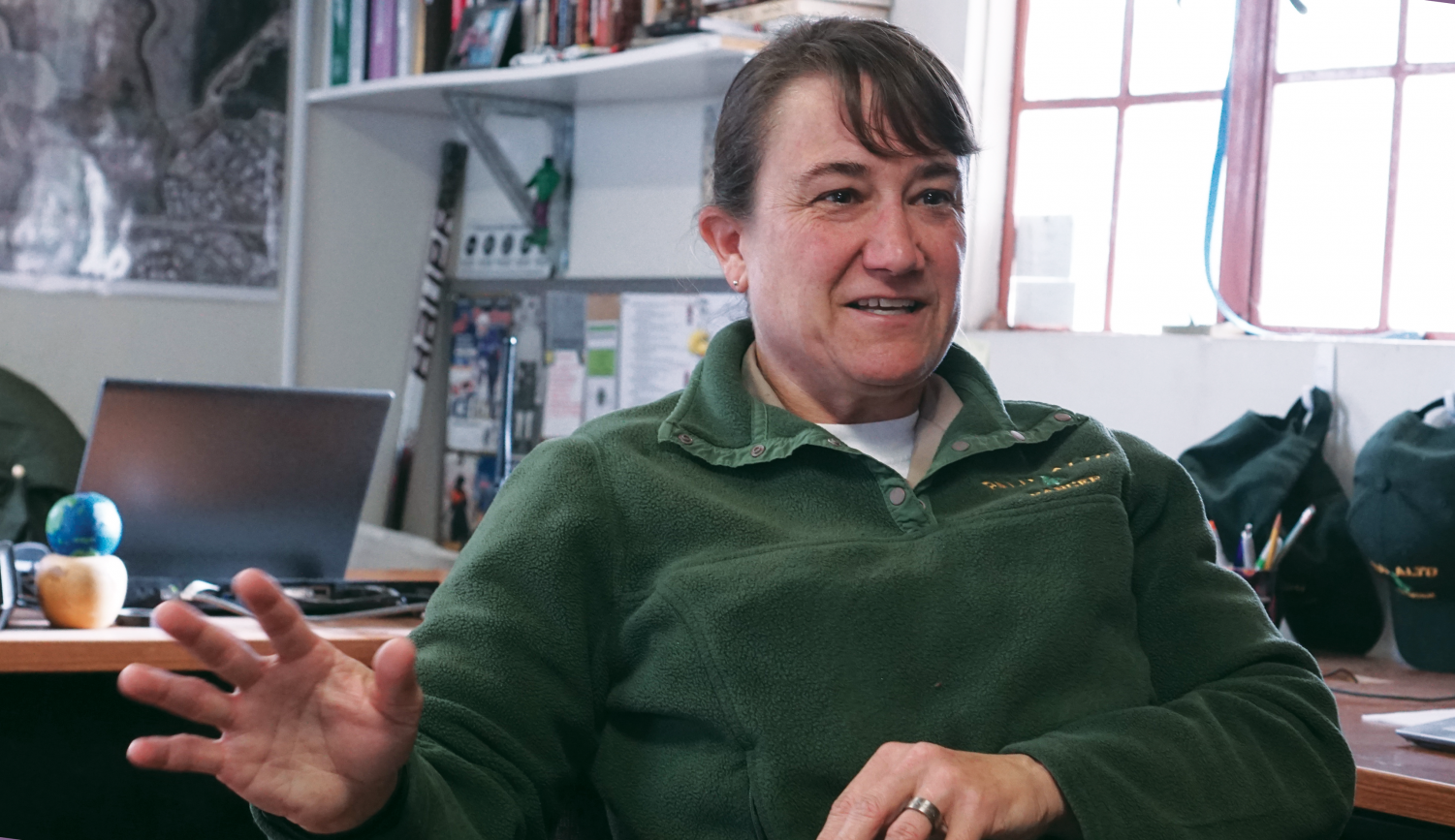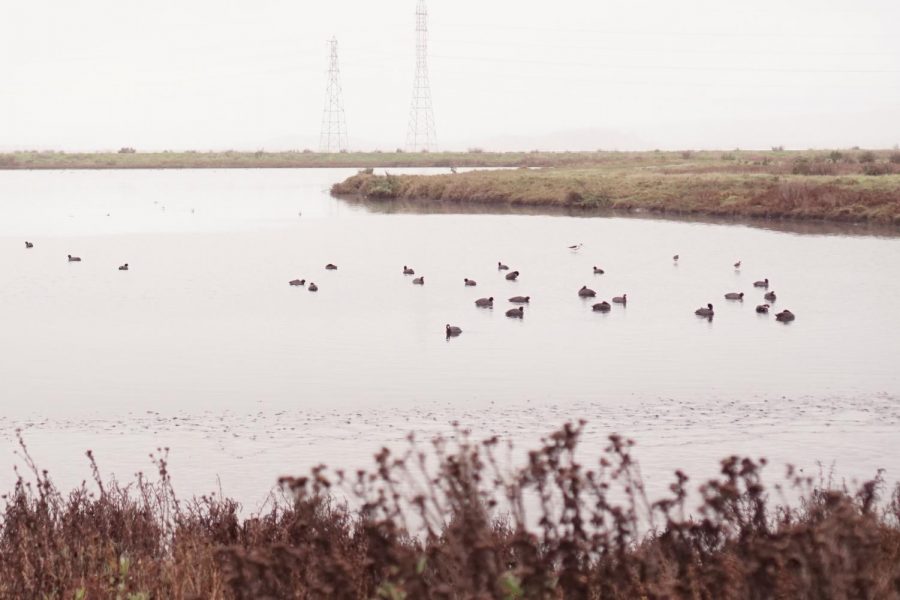In the Weeds
Springing into the Baylands ecology
February 27, 2019
MUD HENS: The American Coot, or mud hen, spends most of its time foraging for food above and below the water. Although they are comfortable swimmers, these birds are clumsy in flight, according to the Cornell Lab of Ornithology. Since they are widespread across the US, they are often used as a proxy for ecosystem health.
Walking through the winter sprinkles at the Baylands, the high tide comes right up to the edge of the path. A few ripples from swimming mud hens and falling droplets are the only disturbances in the reflection of the grey sky on the surface of the water. It’s easy to forget that the dense Palo Alto housing is only a few blocks away.
In the cold winter temperatures, the gum plants and pickleweed become a dried dark brown, but already, a few tender green leaves peek out near the base of the plant (fig. 1). Spring brings many changes to this local coastal wetland, and after 20 years on the job, Supervising Ranger Lisa Myers is an expert in the seasonal variations at the preserve.
Fly by
The Baylands lie in a region known as the Pacific Flyway, according to Myers. This is a common migration route linking the northern and southern habitats for aquatic birds. In spring and fall, hundreds of thousand of birds fly through here to reach a warmer destination.
Three species of ducks even spend the winter in the warmer Palo Alto climate. These colorful birds (fig. 2) can only be spotted in Palo Alto during the winter, and curious birdwatchers can look for them in the lagoon behind the Ranger Station.
Many of these migratory birds use the Baylands as a rest stop on what could be as much as a 9000 mile journey from Mexico to the Aleutian Islands of Alaska. One special visitor that flies through the Baylands on a biannual basis is the Allen’s hummingbird, which weighs less than a paperclip.
Spring
“We can always tell when spring is coming because we will start seeing the American avocet change from being mostly white birds with black wings [to] all of a sudden, they’ll start getting this cinnamony-[colored] head to them,” Myers says.
All the Bayland birds change plumage, or their feather color, during the spring to “attract a friend,” as Myers puts it.
“Oddly, the bird world is the complete reverse of the people world,” Myers says.
The males put on a show for the females with their colorful, flashy plumage while the females take on a larger size and darker shade, so they can retrieve food, hide and protect their young, according to Myers.
A parasitic plant called dodder (fig. 3) flourishes during the summer and fall as it feeds on lush pickleweed. People often mistake the clump of orange as a disease, though it is a natural part of the ecosystem.
Cliff swallows, barn swallows (fig. 4), Rufous hummingbirds and Allen’s hummingbirds (fig. 5) also appear during the spring and summertime near the nature center. Barn swallows, which have forked tails, gather underneath the building while flat-tailed cliff swallows cluster on the roof.
Critter Tales
 Supervising Ranger Lisa Myers tends to all aspects of the Palo Alto Baylands — whether that be maintenance, like cutting up a tree that has fallen across the road or catching loose pets.
Supervising Ranger Lisa Myers tends to all aspects of the Palo Alto Baylands — whether that be maintenance, like cutting up a tree that has fallen across the road or catching loose pets.
After Easter, many people abandon pet rabbits or chicks in the Baylands nature preserve, assuming that the animals will survive in the wild, according to Myers. She then gives them to animal services to find a home.
Thankfully, none of these released animals have made a permanent habitat of the Baylands ecosystem, though once, many pheasants lived there for a few years. Myers guesses that these pheasants, which are native to Asia, first arrived in the preserve after a farm shut down and released them.
On one occasion, she put out a grass fire after some young Palo Altans launched model rockets. In the past, brush fires caused by fireworks were common, but according to Myers, the public has been more cautious.
Although Myers may spend much of her time reviewing environmental action plans in the ranger station, supervising volunteers, or leading nature walks, she is always prepared to confront any situations that need tending to.
Bay watch
Myers often conducts interpretive walks with children in which she points out local effects to spread the awareness of global problems like sea level rise or pollution.
From February to December, rain increases water levels, and when tides are high, the marsh threatens to flood paths. In the past, Myers has used one row of sandbags to protect the area from flooding, but with sea level rise, she now needs three.
Currently, there are different zones of plants based on their exposure to moisture due to tides: plants that are wet all the time, which includes cordgrass, plants that are wet much of the day, like pickleweed, and upland plants, like salt grass and gumplant (fig. 6). As sea level rises, more of the dry plants will become submerged, reducing key habitats. The salt marsh harvest mouse, an endangered species, relies on these dry bushes as cover to hide from hawks.
The Ridgway’s Rail is another endangered species that sometimes hides in the gumplant. These skinny, hen-like birds are easily identified by their long beak and orange breast.
“We hear those guys every single morning. Just as the sun starts rising, you can hear cak-cak-cak-cak-cak — [they’re] talking to each other.” Myers says.
Non-native foxes, an invasive species, are one of their main predators. Especially because of their patchy distribution, foxes can easily hunt the small population.
To combat this problem, contractors built refuge islands covered in pickleweed and gumplant for small birds like the Ridgway’s Rail. As the bushes they hid in are becoming submerged, these islands allow birds to hide during high tide from their predators flying past, like peregrine falcons or northern harriers, according to Myers.
Looking up
Even if the Baylands environment is threatened by global climate change, pollution has decreased since the local yacht harbor closed, according to Myers. It had been a major source of pollution because boats often dumped human waste. Additionally, the white paint on older boats usually contained lead which chipped off and contaminate the water.
Water from the Palo Alto creeks — Adobe, Matadero, Barron and San Francisquito — carries an abundance of fine sediments to the Baylands.
Storm drains feed directly into these creeks, which is why it is so important to avoid dumping garbage into them, even as other pollution reduces.
“Think of this area as just like a big bowl, and the Baylands is at the bottom of that bowl,” Myers says. “We’re the drain, and all the plants and mud act as a big sponge.”
Correction: The print edition of this story misspelled the bayland species described by Myers as the “American abbasset,” as opposed to the American avocet. Veritas Magazine would like to apologize for this error.
